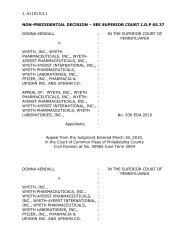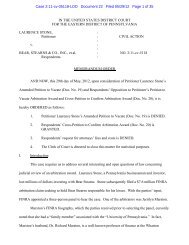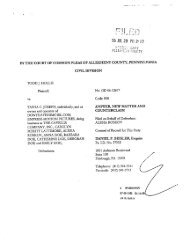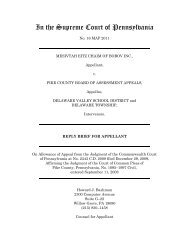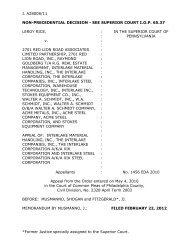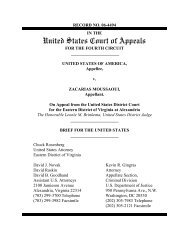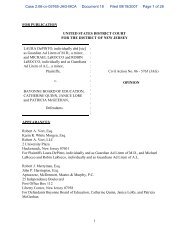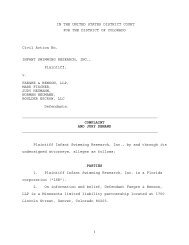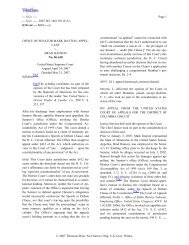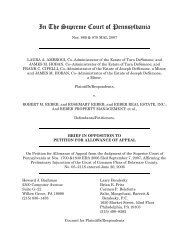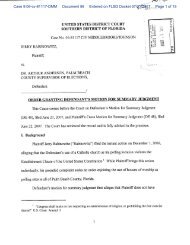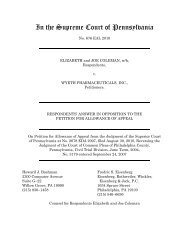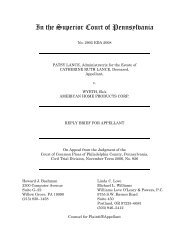petition for rehearing en banc - How Appealing
petition for rehearing en banc - How Appealing
petition for rehearing en banc - How Appealing
You also want an ePaper? Increase the reach of your titles
YUMPU automatically turns print PDFs into web optimized ePapers that Google loves.
RULE 35 STATEMENT<br />
Conrad M. Black and John A. Boultbee respectfully <strong>petition</strong> <strong>for</strong> <strong>rehearing</strong> <strong>en</strong> <strong>banc</strong> of a<br />
decision r<strong>en</strong>dered by a panel of this Court (Posner, Kanne, & Sykes, JJ.) on October 29,<br />
2010, following a reversal and remand by the United States Supreme Court. The Supreme<br />
Court unanimously ruled that one of the two alternative theories of mail fraud that were pre-<br />
s<strong>en</strong>ted to the jury is not a federal crime, and it remanded <strong>for</strong> consideration of whether the<br />
governm<strong>en</strong>t can establish harmlessness beyond a reasonable doubt. On remand, the panel<br />
ruled that while the error was prejudicial as to two counts of fraud, it was harmless as to the<br />
only remaining fraud count on which the jury convicted (count 7) as well as one count of ob-<br />
struction of justice, which applies to Black alone (count 13).<br />
The panel’s decision warrants <strong>en</strong> <strong>banc</strong> review under FRAP 35(a)(1) because every perti-<br />
n<strong>en</strong>t Supreme Court decision in the last 40 years, beginning with Chapman v. Cali<strong>for</strong>nia, 386<br />
U.S. 18 (1967), has rejected the mode of harmless error analysis embraced by the panel. See,<br />
e.g., Rose v. Clark, 478 U.S. 570, 578 (1986); Yates v. Evatt, 500 U.S. 391, 404-05 (1991);<br />
Sullivan v. Louisiana, 508 U.S. 275, 279 (1993). Review is also warranted under FRAP<br />
35(a)(2) to resolve a question of exceptional importance: Wh<strong>en</strong> a jury is instructed, in viola-<br />
tion of the Due Process Clause of the Fifth Am<strong>en</strong>dm<strong>en</strong>t, that it may convict of conduct that is<br />
not a crime, is it consist<strong>en</strong>t with the jury-trial right guaranteed by Article III and the Sixth<br />
Am<strong>en</strong>dm<strong>en</strong>t <strong>for</strong> an appellate court to deem the error “harmless” based on its own favorable<br />
assessm<strong>en</strong>t of the persuasive power of the governm<strong>en</strong>t’s case, without accounting <strong>for</strong> the<br />
evid<strong>en</strong>ce supporting the def<strong>en</strong>se or the fact that the jurors who actually heard that evid<strong>en</strong>ce<br />
acquitted def<strong>en</strong>dants on almost every charge—including those where they necessarily re-<br />
jected the same evid<strong>en</strong>ce on which the panel relied? See, e.g., Neder v. United States, 527<br />
U.S. 1, 15-16 (1999) (harmlessness review must be conducted “on the whole record”);<br />
United States v. Vonn, 535 U.S. 55, 68 (2002) (“<strong>en</strong>tire record be<strong>for</strong>e the reviewing court”);<br />
Hedgpeth v. Pulido, 129 S. Ct. 530, 533 n.* (2008) (“record as a whole”).



